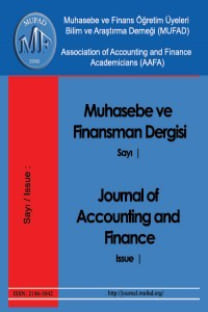Possibilities For Managing Financial Crises Of Macedonian Companies
Financial crises, companies, financial restructuring, merger and acquisition, turnaround concept
___
- Block S., Hirt G, (2008), Osnove finansiskog menadzmenta, McGraw-Hill Irvin.
- Velimirovic M.,(2003), Sadržaj i dejstvo stečajnog plana, Pravni život N. 11.
- Janikijevic N. (2003), Organizacione promene u razvoj, Beograd.
- Kokotec – Novak Majda, (1997)Racunovodski vidik sanacije podvjeta, Zbornik referatov 29 simpozija, osodobnih, metodah v racunovodstvu in poslovnih financah, Portoroz: Zveza ekonomistov Slovenije in zveza racunovodi, financnikov in revizorjev Slovenije.
- Mićović M., (2004), Reorganizacija ili redresman stečajnog dužnika, Pravo i privreda, Volume: 5-8, Beograd.
- Miroslav M. Todorovik, (2005), Finansijsko restrukturiranje korporacija, Ekonomski fakultet, Beograd,
- O’Neill, H. M., (1986), Turnaround and recovery: What strategy do you need?, Long Rang Creditor Rights in Insolvency Procedure”, Sydney, November 1999,
- www.oecd.org
- Pajunen K., (2005), Stakeholder Influences in Organizational Survival, Journal of Managment Studies.
- Pittaluga Rodolfo Jr., (2000), U.S. Bankruptcy/Insolvency laws and foreign bankruptcy proceedings.
- Richard A.,Stjuard C., Frenklin A., (2011), Principi na korporativnite finansii, Ars Lamina, Skopje.
- Stieve M, Karoline G., (2012), Pretpriemastvo i upravuvanje so mali biznisi, Ars Lamina, Skopje.
- Smith, M. i C. Graves, (2005), Corporate turnaround and financial distress, vol. 20 (3), Managerial Auditing Journal.
- Stuart C. Gilson, (2006), Creating value through corporate restructuring, John Wiley & Sons, Boston.
- UNCITRAL, (2004), Legislative Guide on Insolvency Law (June), www.uncitral.org.
- Freshfields Bruckhaus Deringer, (2004), The EU regulation on insolvency proceedings (June),www.freshfields.com.
- European Bank for Reconstruction and Development, (2006), Transition Report.
- http://www.coba.usf.edu/departments/management/
- http://www.byrneassociates.co.uk/adrec.html
- http://www.crm.com.mk
- www.pravoeu.jura.kg.ac.yu
- www.oecd.org
- www.economics.ag.utc
- www.wordlbank.org
- www.uncitral.org
- www.economy.gov.mk
- ISSN: 2146-3042
- Yayın Aralığı: 4
- Başlangıç: 2005
- Yayıncı: Muhasebe ve Finansman Öğretim Üyeleri Derneği (MUFAD)
Momentum Anomalisi: BİST 100 Endeksine Yönelik Araştırma
Possibilities For Managing Financial Crises Of Macedonian Companies
Biljana ANGELOVA, Neda PETROSKA-ANGELOVSKA, Marija ACKOVSKA
Semra Aksoylu, Derviş Boztosun, Fatih Altınışık, Emre Hayri Baraz
European Central Bank -Conventional And/Or Unconventional Instruments For Monetary Policy
Klimentina POPOSKA, Elena MIHAJLOSKA, İskra STANCHEVA-GİGOV
Balkanlarda Transfer Fiyatlaması
Batuhan GÜVEMLİ, Halil İbrahim ALPASLAN, Mehmet Emre ŞUŞOĞLU
Influence Of Budget Deficit On Economic Growth: The Case Of The Republic Of Macedonia
Aleksandar NİKOLOSKİ, Pece NEDANOVSKİ
Beklentiler Ve Güven Endekslerinin Finansal Piyasalar Üzerine Etkisi
Semra T. ALTUNTAŞ, Vedat SARİKOVANLİK, Nertil MERA
Mihriban COŞKUN ASLAN, Serkan DEMİRKAN
Belediyelerin Mali Tabloları İle Nüfus Arasındaki İlişkinin Analizi 1980 – 2014 Arası Analiz
Gülistan BAŞCI, Eşref Savaş BAŞCI
